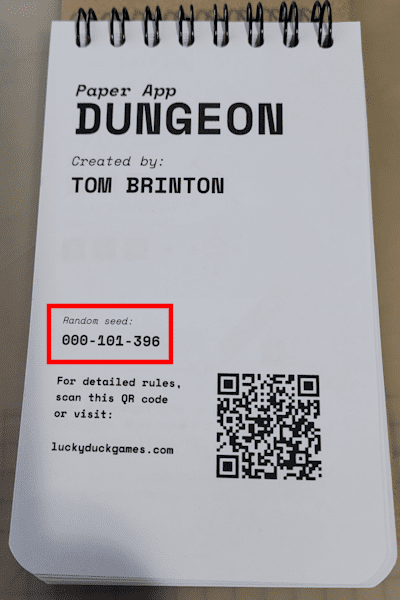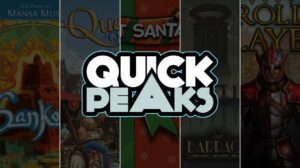Disclosure: Meeple Mountain received a free copy of this product in exchange for an honest, unbiased review. This review is not intended to be an endorsement.

There is a nugget, buried deep within the concept of Paper App Dungeon, that is quite clever. That nugget is the uniqueness of each copy of the game. My booklet, for example, has on its first page the random seed that was used to generate the other pages contained within. I know that my copy is unique; not another one like it.
Once you get past this, there really is little else to say by way of praise.
Playing the Game
The game consists of a small notepad with 60 pages, and a pencil. This is a normal pencil, only where another pencil might say it is a #2 or have a brand name, this has the numbers 1 thru 6 on each of the sides, turning it into your pencil-die (called a p6 in the rules).

The first part of the booklet is a summary of the rules. The full rules, the booklet states, are available via a 2D barcode or on the Lucky Duck Games website. If you speak French or Polish, then that is true. The website does not have a copy of these rules in English. I was able to find a translated document online. I have no idea if these are properly translated, but they worked well enough.
Next, there is a stick-figure like outline for you to decorate your hero and give them a name.

Then we dive into level 1 of your dungeon. On each dungeon level, there is an outer wall made up of 15 blocks to a side. The 13×13 grid grid inside contains more walls which divide the grid into rooms, and your standard dungeon-crawler fair: monsters, treasure, healing potions, and so on. There is a staircase which you use to move on to the next level, and a smiley face indicating where you start.
All of this is intriguing until you realize you have very, very little to do here.

As you go into each level of the dungeon, you first record your current hit point level and number of coins from the previous dungeon level. From there you roll your p6—odd means you need to move diagonally that many spaces, even means you need to move orthogonally that many spaces. Once you pick a direction, you continue in that direction for the number spaces indicated until you are blocked by a wall, at which time you can change directions. These two choices—the choice of your initial direction and the choice of which direction to change into when you encounter a wall—are, quite honestly, the only choices you get to make in this game. And the full rules truncates them:
- You cannot retrace your movements from this turn or the previous turn
- If there are any options where you can move and not encounter a wall, you must take one of those
So, a line of movement with a wall that would allow you to change directions and do something, or three options that each land you in a nest of monsters? No choice. Deal with it. The first thing you need to do, if you insist on playing this game, is house rule that particular restriction right out of existence.

Every object that your path crosses, you interact with (e.g., gain coins, take damage, lose coins, heal damage, etc.). Most objects can only be interacted with once and you have no choice. Roll your pencil again and repeat the process until you reach the stairs. If you reach the stairs and choose to use them, you have completed the level and get to move on to the next one.
When you leave a level, you total up the hit point gains and losses and record your final hit points. If this is less than 1 hit point, you have died and need to record the death on the final page of the booklet and reset yourself to 10 hit points. If you survived, you then total up record the coin gains and losses and record your final number of coins; if you died, you record zero coins.
Every so many pages, you find yourself in a shop where three items are available for you to buy with those coins you have collected. This might be food to regain your hit points; scrolls that give you one time powers, etc. Given the procedural nature of this game and the limit of three items per shop, I was shocked at how little variation exists here. Shops are often identical. I was really hoping to see more variety.
If you trudge your way through all of the levels of your dungeon (mine has 44 levels; not sure if that is the same for all booklets), you are presented with a randomly generated name for a gemstone you find in the treasure room. Finally, you go to the last page (again?) and enter your final coin value and your final hit points. This will be right next to the tally of your deaths.
Game over.
Thoughts
Before we get into the final thoughts, I just want to say that when I saw the pencil-die, I thought this was quite cool. Then I tried using it… if you are going to use the pencil as your randomizer, have a very flat and level surface to play on. It is my understanding that the Kickstarter version came with a d6. I suggest you grab one and save yourself some frustration. Because the game itself is frustrating enough without that pencil getting in the way.
This falls into a category of product where I seriously question its status as a game. In my humble opinion, a game needs a certain degree of player agency. Some might go so far as to say that there needs to be a winning condition, not just an end. This product comes up short, it is not a game so much as it is an activity. One could make the argument that the movement system provides player agency, but this is an illusion: what agency might exist is stripped away by the restrictions placed on it.
Oh, and by the fact that the game has no goal. Read that again.
- Survival is not the goal. Dying is an inconvenience at worst; can be advantageous at best.
- Treasure is not the goal. It can buy a few boons every few floors, but nothing else.
- Advancement is not the goal. There is no advancement in Paper App Dungeon.
I tried to find a goal, and it just isn’t there. Neither the booklet, nor the full rules, suggest that the designer or publisher knows what the goal might be. Consider that if you were to die on the last floor, you still get into the treasure room, you still complete the game no worse for the wear. In the end, the whole exercise is pointless.
This product is less desirable than a standard, blank notebook. But at least I can use the pencil as a pencil, I guess.











Add Comment